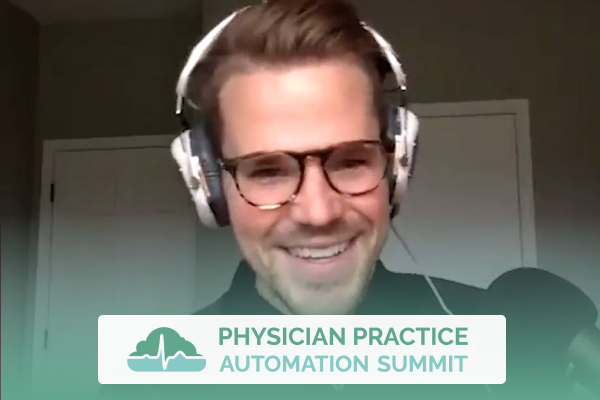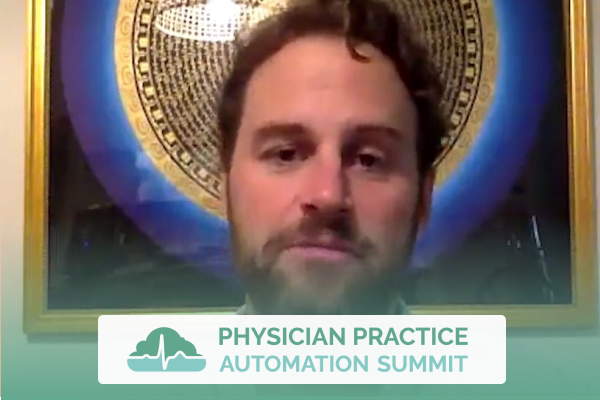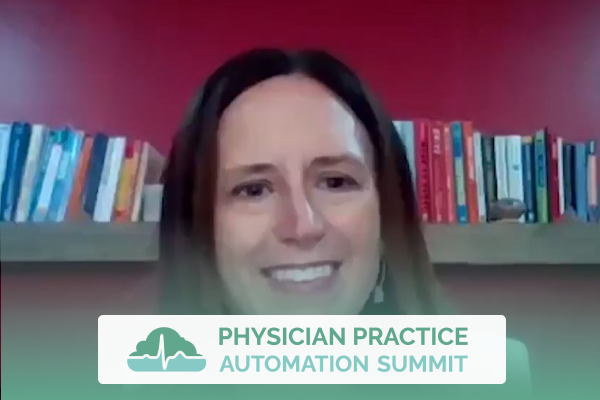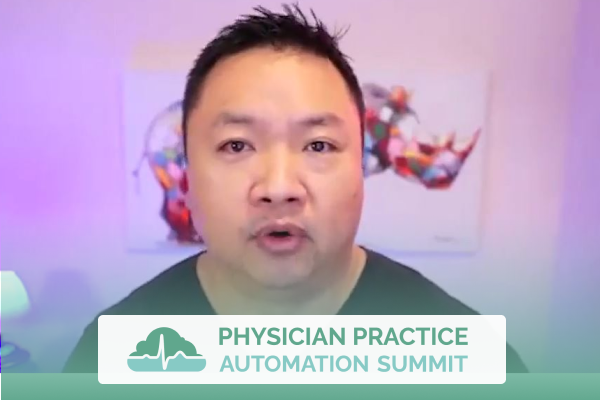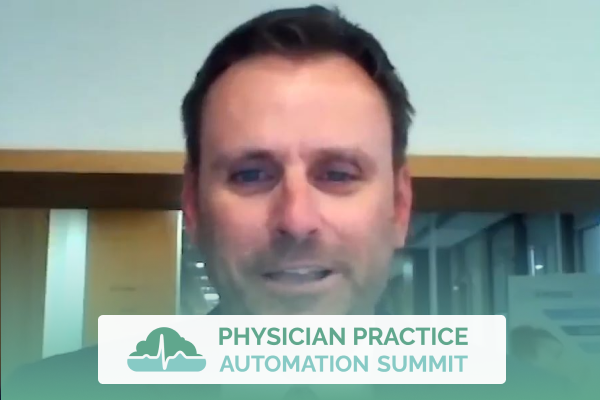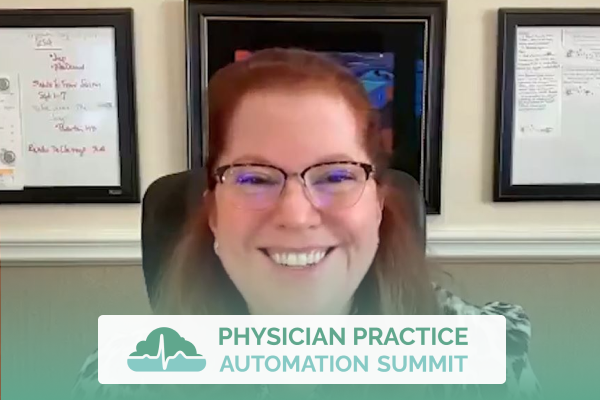Join the discussion below
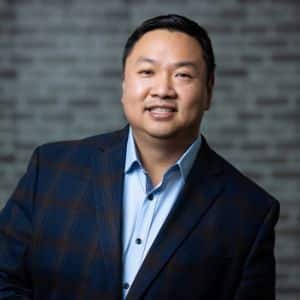
Dr. Ruan is the Founder and CEO of Texas Center for Lifestyle Medicine. He devotes his career in practicing and building systems that allow for efficient delivery of healthcare. He is a board certified internal medicine physician but also have advised with companies to improve their workflow, company culture, marketing,... Read More
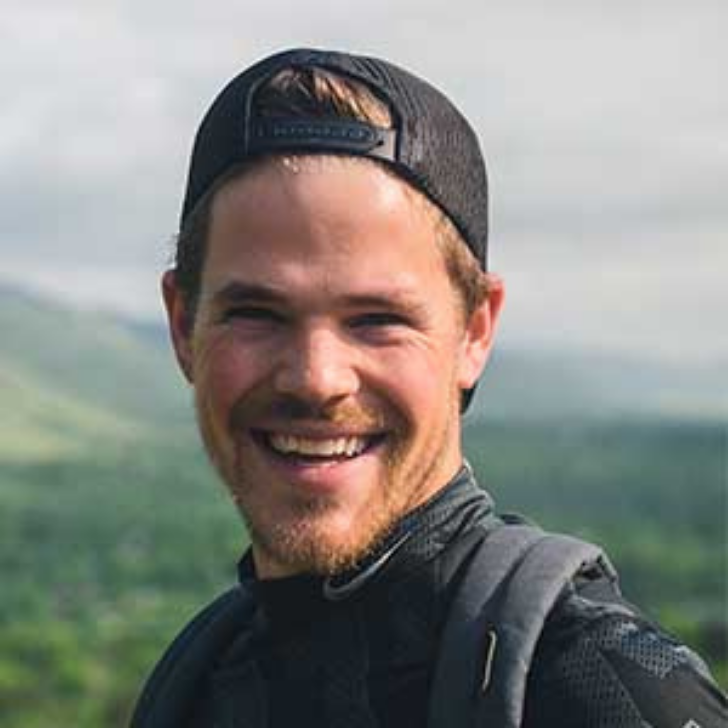
TJ Anderson is a Behavior Change Specialist, Bestselling Author of THE ART OF HEALTH HACKING & Director of Engagement at Heads Up Health. With an extensive background in patient engagement and sustainable health behavior change, TJ makes it easy for root-cause health practices to integrate remote health monitoring in their... Read More
Cheng-Huai Ruan, M.D.
Hey everybody. One of my really good friends here today. Super special because I was just hanging out in his cookbook. Which I’ll introduce in a little bit but this is TJ. TJ Anderson. He’s a Behavioral Change Specialist. Ah, Best-selling Author of The Art of Health Hacking. And then he’s got this other really cool book called Kitchen Chemistry that’s designed for couples to really make some chemistry in the kitchen. It’s mostly Paleo but I actually use it with my daughters as well. So it’s kind of cool what we’re actually using it for. Yeah.
TJ Anderson
It’s great.
Cheng-Huai Ruan, M.D.
But the reason that TJ’s on is because he is part of this wonderful company called Heads Up Health. And he is, are you the Director of Engagement? Is that what it is?
TJ Anderson
Yep. Sales and Engagement at Heads Up. Yep.
Cheng-Huai Ruan, M.D.
Director of Sales and Engagements. So he’s got pretty extensive background in patient engagement, sustainable health behavioral changes. And then it makes it really easy for guys like me to try to figure out the root cause of disease but also using technology because sometimes you are limited to what you can do by your limitations in technology. But Heads Up Health has got something that’s pretty special that I actually haven’t seen before in a lot of different companies. And it’s not just about technology but it’s how it’s actually implemented as well. So, this sound’s a little cryptic so I’m really going to have TJ talk about that during this interview. So, thank you. Thanks for coming on. Thanks for taking the time out of your day to come on. I appreciate that.
TJ Anderson
I’m honored to be here. I’m excited to jam with you. I know we both have lots of passion on these topics and it sounds like your audience does as well so, excited to connect with them.
Cheng-Huai Ruan, M.D.
Yeah. So, you know, as we are you know, I’m supposed to say as we enter the pandemic but I don’t think that’s happening right now. As we continue on into the pandemic obviously, you know, a lot of things have changed in the medical community and everyone, everyone is starting to talk about technology. So you see these companies that come out with you know, tracking COVID outcomes tracking oxygen saturations remote patient monitoring but this is something that’s been in your space even before the pandemic, right?
TJ Anderson
Yeah. So our organization headsuphealth.com or Heads Up for short we’re all about organizing and analyzing data all in the same place. And so we actually started direct to consumer back in 2016. I had the honor of interviewing our founder, Dave Korsunsky on my own podcast about two and a half years ago prior to joining the team. And, he explained it as an electronic health record for the individual except it’s simple, sleek and sexy. And so that really caught my attention. I had just finished writing my book all about how the individual can truly take their health into their own hands and become a health hacker. So, I fell in love with the platform first, personally like a lot of people do. And then right before the pandemic or before COVID came out we had launched B2B. So, we launched in early 2020 to help practitioners, coaches, patient facing health professionals get access to their clients or patients data all in the same place. So, that’s our origin story. Started direct to consumer and then pivoted to go into the practitioner space.
Cheng-Huai Ruan, M.D.
So that’s pretty unique because there’s a lot of companies that I talk to originated with the B2B format which is, they’re marketing to physicians or practices or medical systems to monitor this data. So, what I’m super curious about what did you really see? How were people adopting technology on their own outside of a doctor’s setting? How was that being done?
TJ Anderson
Yeah, good question. So, typically you could maybe put them into a couple of buckets, right? You’ve got your, you know your fitness crowd, your bio-hacker crowd your wellness warrior crowd, right. Kind of all in one bucket. And then you’ve got those that have maybe some conditions that they don’t just want to manage but they want to hack. They want to improve and they want to use data to really improve those conditions and have better outcomes. So, you know, whether it’s a connecting a glucometer or a bluetooth scale to our platform or a number of wearables such as, you know, the aura ring. Which I’m wearing right now in this interview. You know, it’s taking control and, you know, a lot of it’s the cutting edge people but it’s those that also need more more guidance and more insight into their own health beyond the four walls of the doctor’s office. And, so that’s what we’ve really seen. So we’ve, you know, a lot of glucose data a lot of ketone data, you know one of our early partners was a device called the Keto Mojo. Blood glucose and blood ketone data. So yeah, we have a lot of keto diet experimenters. A lot of bio-hackers at first but it’s opened up since then.
Cheng-Huai Ruan, M.D.
Yeah. So, but you guys decided to go to the B2B market. Which is marketing to practices and stuff like that. How do you see practices adopt onto a platform like this? Before you answer that I’m going to have you compare, okay?
TJ Anderson
Uh huh.
Cheng-Huai Ruan, M.D.
So I’ve talked to a bazillion companies. Bazillions probably not the right number at least 15. At least 15 companies. Looked at wearable tracking. Right. There’s Apple, and there’s Withings and all this stuff like that. And there’s major institutions like University of Pennsylvania and Oschner are looking at vital statistics. So vitals, meaning like blood pressure weights, heart rate, oxygen saturation, and stuff like that. So, the idea is you start from kind of like a population health side. And then, earlier in 2000 end of 2018, beginning of 2019 there was these reimbursable codes that came out for remote patient monitoring. It was Medicare at first. Now it’s other commercial and private companies.
So, remote patient monitoring has been out for a couple of years. And so what remote patient monitoring is is monitoring these specific vitals. And then when the pandemic hit and it’s like someone poured gasoline on a fire and all of a sudden you have a lot of remote patient monitoring companies coming out. But none that I know of, I could be wrong have really come from the direct to consumer space. So one of the topics on this summit is providing a tremendous amount of value and over-delivery to our consumer. Which are our patients, right. And so that’s why I’m having you on but let’s talk about the monitoring here. What, you talked about the bio-hacker crowd and those people that just want more data to know their outcomes. But what is it about this technology that’s going to make it attractive on the doctor’s side? Okay? To interact with the patient? What do you think specifically based on what you’ve seen in the direct to consumer space?
TJ Anderson
Good question. So, what about us is uniquely valuable to practitioners?
Cheng-Huai Ruan, M.D.
Yeah.
TJ Anderson
Yeah. Well, so one of the guiding principles we have is that we’re about bringing in the most important health data all in at the same place. So what that means is, we’re device agnostic. We’re lab testing company agnostic. If, you have-
Cheng-Huai Ruan, M.D.
Can you define what that means?
TJ Anderson
And, yeah. So, meaning we are we, we’re open to partnering and we have partnered. We have 17 direct integration partners for lifestyle data as opposed to, oh, here are the here’s the one pulse oximeter you can use or here’s the one scale you can use or here’s the one glucometer you can use.
Cheng-Huai Ruan, M.D.
Oh I see what you’re saying.
TJ Anderson
Instead, we partner with the best of the best companies who are out there and allow the practices to choose what data and what devices are most important to them and then we can build and tailor the experience so that it’s customized and personalized to their patients.
Cheng-Huai Ruan, M.D.
Oh, we’re going beyond just vitals. Right? You’re wearing an aura ring, which attracts. Right. That’s one of the examples, right?
TJ Anderson
Yes.
Cheng-Huai Ruan, M.D.
What are some other things that you guys integrate with that a lot of companies don’t?
TJ Anderson
Sure thing. Yeah. So, well, I think a couple you know, things to kind of hit on there are important differentiators, you know. It’s not just life it’s vital sign data it’s lifestyle data but it’s also clinical lab testing data. And it’s not just housing that lab testing data in a PDF format but it’s digitizing that and structuring it. Just like we do on the vital signs side. And then we have analytics features on our platform. So, we were born as like personal health analytics. So we have the ability to allow an individual or a practitioner or coach anyone on the care team to run a report on clients’ progress. So, using our system today you can analyze any data point over any time period and track and see how data points are trending over time.
So we allow you to compare time periods to each other and create these like really simple yet beautiful, like valuable, powerfully engaging reports that help tighten the feedback loop on where your clients are going. So, it’s not just like oh, let’s see who let’s see what chronic disease patients are out of range. Like, we have those features to track typical RPM. And we support a lot of practices with using our system for RPM but it’s also about how do we optimize health outcomes? So one of the big reasons we pivoted B2B is we asked ourselves how can we make more of a difference in the world beyond just direct to consumer and who are the types of practitioners if we thought about going that route would we want to work with? So, our niche is supporting root cause clinical practices.
With leveraging the power of technology without letting it overwhelm the staff or patients. And that’s an important point. A lot of people, when they like you said ,all these companies are coming out with all this tech and as the innovation curve goes faster and faster it gets steeper and steeper and overwhelm can happen to lots of practices. So one of my roles, that I’m really passionate about is like let’s slow things down. Let’s define like what success looks like. Let’s look at the business model and determine you know, what makes the most sense. And so, that’s guided us towards partnering with clinical practices to deploy our system in a way that is both engaging for the client you can use that as a remote health monitoring platform as well but it’s really all about creating better outcomes at scale. It’s like personalized data-driven outcomes at scale. I hope that’s helpful.
Cheng-Huai Ruan, M.D.
It is. It is, because there’s another company that is on the summit here. It’s their upcoming theme. So, that one is really talking about digitalizing PRO data which is patient report outcomes. How a patient does on a specific protocol medication regimen, surgery, et cetera, et cetera. So, this is sort of the other side to it. Which is, you have I guess, wearable devices or even non-wearable devices but devices in general, plus lab. Lab integrations too. Right? And then have those outcomes. And I guess you can make a custom report based on whatever it is you want to see. Is that correct?
TJ Anderson
Exactly. Yeah. So when I’m talking to a practitioner it’s like, what types of clients are you working with and what data is most important to you? Right. Both on the lifestyle side and the clinical side. So, we do have direct integrations with labs but we also have, you know, bulk CSV upload. To upload as many bio-markers on as many patients all at the same time. And, so, we’re all about streamlining streamlining the organization of the data for the individual and the practitioner to have it all in the same place. So that you’ve got better insights and you can then use our analytics features to truly track trends. And what we’re finding is that this truly tightens the feedback loop on the client’s experience and the client becomes more engaged and motivated.
So, we like to say there’s four different types of data on the lifestyle side. So we’re known for our dashboard. If anyone wants to check us out so it’s headsuphealth.com. Heads Up Health.com. Anyone can create a free account and kind of play around with it. And, where I’m helping practices is first understand their model and then that can influence how you deliver a system like ours. You know, I’ve led a presentation called The Cash Pay Way. Right. All about how you leverage a remote health monitoring system like ours in a way that helps to, you know, support the bottom line. And what does that look like?
Because, change management in practice is pretty difficult. You probably have a lot of experience with that. So, the four different types of data on the dashboard is the way we look at is metabolic health data, sleep movement and recovery data. Vital signs, and body composition. That’s kind of how I’ve grouped it in those four categories. And, so, you know we have direct integrations with CGM companies such as Dexcom and Freestyle Libre. So continuous glucose monitoring data. Keto Mojo for glucometer. Bio-sense for breath ketone acetone and then online nutrition apps. But then we also bring the wearable data in from like an Apple watch or an aura ring or, you know, a garment. And then of course like blood, blood bluetooth blood pressure data, and scale data.
And what we’re finding is the client the practices that roll this out properly the client engagement is skyrocketing. Patient engagement is skyrocketing. Churn rate, cancellation rates are going down. And the top practices that like really integrate this and not just not just recommend devices but actually include devices in their offerings. That’s the game changer. So I want to kind of highlight that. I don’t know if you can relate it with your practice but, you know, instead of having your clients have your patients have to like choose what device they want and like buy it separately why not include it in a bundle program? So that they just have to say yes to one thing. Your program. And then everything else is streamlined. So, that’s kind of it gives a glimpse into how, you know we suggest you explore rolling it out in a practice. Yeah.
Cheng-Huai Ruan, M.D.
So this is great, because you know technology is really changing the way we practice medicine. Right? I mean the practice of medicine hasn’t really stepped outside of the one-on-one physician or practitioner visit in a long time. Well ever, until very recently. Right? And then of course you have the global pandemic and telemedicine became like a thing. And it became a thing not because doctors were we’re adopting the platform it’s because patients now expect it. I think. This year. And that, you see it everywhere. So the, market’s moving in that direction but where the market’s moving next you’re absolutely right, is going to be devices and outcome data based on these tracking mechanisms but allows the patients to be in the conversation. Right. And so, there’s going to be a lot of docs who’s listening to me right now listening to us right now and thinking how the hell am I going to make a business out of it?
Right. So, let’s talk about that for a second. You know, in terms of the business of medicine. So, for example, in our practice we don’t have a subscription. We’re not a concierge practice. We’re just a traditional practice. So we use wearable devices and we attract long-term outcomes for, different labs and stuff but you’re right, it’s not all in one place. Which drives me nuts. And in most electronic medical records systems you can do what’s called a flow sheet but you can’t do a population flow sheet. And, it’s really hard to publish on something like that. So, we like to publish because we want to know what we’re doing is actually working for the patient, right. And so, so that’s the value behind it. But from the, those talking from the business side the way I see it is obviously is remote patient monitoring chronic care management but you just said earlier is that some people put it as I guess, a package that people kind of buy into to access this. How does that work in some companies?
TJ Anderson
Yeah. Good, really good question. So typically that’s for a cash pay practice that might have like a bundled program for, you know, 1500, 2000 on up for you know, a three month thing with some testing, some consults, maybe some coaching and some educational content but to take that sort of package you know, maybe some of your listeners have a bundled program similar to that. But to like, to take that to the next level and differentiate adding not just our platform and all the features and the benefits that come with using our platform with the patient but also the devices. What that’s going to do is allow a practice to stack more value, increase their prices, and differentiate themselves compared to other practices. And that’s going to be one of the most important things for a private practice owner to do as they evolve and want to grow is ask themselves how can they differentiate themselves and how can they add more value?
And one of one of our clients was actually telling me the other day he’s like, you know, my patients are now like he mentioned this to me he’s like, every time their using their aura ring or every time they’re stepping on their scale or or using their, you know, Keto Mojo device that integrates with Heads Up because they included that device in their offering. The patients are subconsciously thinking about the practice and the doctor and their experience overall each time they use that device. On a, not just weekly basis, but a daily basis. And that is allowing that patient to feel more confident in their team that and the approach that they’re following and it’s going to help them stay patients for longer and and less cancellation rates.
So that’s typically like, you know, the model for a cash pay practice. Bundle program, and then into a membership model but for the RPM the insurance practices of the world that want to explore, like you said the remote patient monitoring the RPM codes that exist for reimbursable codes through CMS is using our system as well and deploying devices. And it’s, so we have a process and a flow for that of course and it’s like, you know, who’s eligible inside of your patient group you know, what the key thing is to really make sure you’re choosing the right devices, and quality devices. And one of the downfalls of a lot of other RPM platforms frankly, is that they’re you know, devices on the other side of the world that were made cheaply and all about margin and not about quality data and that’s a big risk for practices. Practices need to manage that risk by doing their due diligence and kind of vetting out all the devices to choose from. So, we do, for RPM side we integrate with devices that bring in RPM or reimbursable data. So, blood glucose from keto mojo, libre and dexcom for CGM’s but then, withings, we integrated withings for blood pressure data bluetooth scale data, heart rate and eye health.
Eye Health Labs is another company we integrate with. Apple watch is now beginning to talk more and more about a device that could be reimbursable through RPM. And, we actually have one of the best Apple health integrations. Shout out to my tech team. It’s our third version. It took us a year to build and it just auto-pooled in the background. It’s really sleek. And the really the reason that’s valuable here Apple health, if we don’t have a direct integration with the device, the company wants us to use and that device integrates with Apple watch or Apple health kit and your patients have Apple health we can pull in the data from Apple health kit.
So, you know, we’re currently vetting out some of the top clinically validated, you know blood pressure cuff companies and we’re helping our clients. Our practice clients make the decision of what devices are gonna make the most sense? How are we going to deploy them to our patients? What’s that model gonna look like? And, that fact, and of course, what’s the margin look like? What’s the overall you know, expense to bring on in a program like this and what are the expected revenue outcomes. And, and so, cause it’s got to make financial sense. Right? And so, so yeah, yeah, that’s that’s kind of our flow there on the insurance side.
Cheng-Huai Ruan, M.D.
Yeah. So for those of people who are listening who’s never done remote patient monitoring before, one of the downsides of adopting things early, like us is that you get experienced with of all the pain points first but you know, what TJ kind of said what you said about, you know, devices that are made that break, and mean that tech support can kill a medical practice. Like, no joke. The amount of full-time employee time that’s spent on that can be very devastating. You know, we abandoned our first platform for for this specific reason because when remote patient monitoring first came out it was like the wild, wild west.
You know. People were I think outsourcing or actually white labeling devices from overseas that were, you know, some of the instructions weren’t even in English and stuff like that. And then people got a little smarter and start looking at devices made in the US but they still had the tech issues as well. And so what, so, you’re saying device agnostic which means that if Heads Up health can integrate with multiple devices and can also piggyback on something like Apple, Apple health and my little Apple watch right here we’re actually getting good quality data. That’s already has had quality control by the parent companies. That’s what makes it work.
TJ Anderson
Right.
Cheng-Huai Ruan, M.D.
So, you talked about the cash pay practice a little bit. We talked about insurance-based practices a little bit. And then, I think that there’s really good value for the hybrid practices. Like those people who are doing hybrid insurance and subscription based on and direct primary care and stuff like that. And other, in the concierge type with insurance hybrids. That is a very, very common thing these days. Becoming more common. I think it’s a great way to go for most practices. so, the most famous company to do this and I don’t want to name names right there but what they do is that they charge a fee for a sort of a executive wellness, if you will, once a year, right. And that fee could be, you know, $2,500, $3,500 depending on what it is. And then, they have access to their physicians but they also bill medical insurance.
Right. And so, I think that practices like those can have sort of different tiers. And then also integrating with something like Heads Up Health to look at the data and then it can still can run those hybrids. The caveat being that if if you’re a Medicare or take CMS insurance then you can’t bill for things that CMS already covers. And so, the good news is CMS doesn’t necessarily cover an aura ring or keto mojo and stuff like that. Right. So, there’s ways to kind of divvy that out. And that’s where the awesome part is is because it kind of allows our creative juices to sort of do the things that we want and you know that’s why I love having you on talking about this. So thank you.
TJ Anderson
Yeah, you bet. And I think it’s important because like you said, the RPM world was the wild, wild west and some might still say it is.
Cheng-Huai Ruan, M.D.
It still is.
TJ Anderson
And, so, because of that you know, we’ve actually been really mindful and intentional about how we go into that space. And so we’re vetting and looking at other direct companies to integrate with and we will be coming out with more clinically validated highly respected RPM device companies. Best of the best out there to integrate. And, and so we’re going to one other the thing I didn’t mention is like the drop shipping, for instance. Like how do you get the client’s devices? Like we’re vetting yeah, we’re doing all of that. You know, of course some practices might want some devices in clinic but also shipping direct. There’s one other thing I really want to touch on here in terms of the business model.
You talk about like the hybrid, right? The membership model group and the different tiers. I’m glad you touched on that. And lots of our practices do have that, that model that whether it’s DPC or concierge, high end and it’s either, you know, an annual or you know, a monthly model and you can easily have different tiers. And you can easily you know, for instance you could include Heads Up on its own and maybe a group model for a lower tier. And then on a higher tier you include private training, and coaching, and guidance and consultation around your data. So we’re consulting with our practices on how they roll this out and position it in the right way because we don’t want to we’re not just selling a software to a company and you know, have it be shelf ware. We want it to be valuable and actually benefiting everyone involved. So, within that so because of that we are also in the process of guiding our practices on potentially how to include proper team members to use our system, right. And so the health coaching coaches of the world and care coordinators and other patient facing health professionals.
So when you think about using a system like this it’s, don’t think about like oh, I don’t have the time to do this. It’s like, you know, begin with the end in mind. Like, who can you bring to the table? What type of experience do you want to create for your patients? And is there an ideal type of team member that you could bring on? And maybe you can attest to this a little bit too. The power of health coaching type roles any patient facing health professional trained as a health coach that leans in and communicates with each client and patient you know, every week and has calls and checks in on their data and reminds them. And so that’s what we’re building our system for is to think of it, you know as a really like a collaborative care platform all focused on health optimization health outcomes, better health outcomes. Yeah.
Cheng-Huai Ruan, M.D.
That’s very powerful. ‘Cause there’s other people that are interviewing for the summit that’s focusing on exactly this. And we have Harvard and UCSD talking about their integrative health coaching platforms reach out to communities. There’s practices in New York that has over a million trackable outcomes with us last year for, for the pandemic. And it’s all health coach derived. And then in, April 1st, 2021 there’s a new taxonomy that’s put out by center for Medicare Medicaid services. And that taxonomy is health coaching. So, there’s now now it’s, I guess it’s sort of a sub specialty within the non-physician qualified healthcare professionals. So now we’re entering this era where a lot has changed on the federal side And that stuff like this can be executed by health coaching can be utilized within CMS within Medicare and Medicaid services and within Tricare Military Insurance and stuff like that.
So, I mean, this is I mean, if you’re listening to this on the summit it’s one of the first places that you’re going to hear us talk about this because by, I think by two years from now this is going to be more commonplace. Using digital data, and utilizing good quality digital data, Like, we didn’t do in the very beginning but to also improve the user experience. Improve our patient experience and improve the value that we as physicians can deliver to our patients. Right? And so, that’s something I really appreciate. But there’s also going to be people that are naysayers. I want to put out maybe a couple of points. So the first one, is fear of the known. And so, the fear of the-
TJ Anderson
The what? I didn’t, oh.
Cheng-Huai Ruan, M.D.
Oh the fear of the unknown. The fear of the unknown. Yeah. So, the fear of the unknown is oh my gosh, I’m going to get this data and how am I going to be able to sort of keep up with this data or what I necessarily do with this data, right. Now, even onboarding practices for awhile. So what has your experience in that onboarding process ’cause I’m sure they asked you that question?
TJ Anderson
Yeah. Yeah. You bet. I would, so someone’s fear of the unknown or unsure of how something works first thing I would say is like get your feet wet. Like play around. Like start connecting your own data. Use it, use if you were wanting to build your own electronic health record of your own health data. So, so that’s kinda how I’d how I’d first start with that. But then the second point is like I mentioned how every client of ours we customize the platform. So we tailor the dashboard and can build a default customized dashboard for all clients that you can then customize at the patient level. So it is, it’s highly personalized and you can make it as simple or as complex as you want it to be.
So if someone is maybe on leaning on the side of overwhelmed then we would definitely focus on simplicity. What are the top lifestyle metrics? Maybe the top 10 top, maybe even less. And what are the top labs that you run on patients? And, let’s scope that out. Let’s build a pilot for you to maybe experiment with a handful of patients and oh and maybe also ask your team. You know. I think, I think those that are overwhelmed it’s a combination of like, understanding like what exactly will this take from like time, money, and energy and effort overall but then like who else on your team can you bring to the table to really help? Right. And I think probably often times practice owners might get a little overwhelmed because they think they need to be the ones that do everything. Right.
As opposed to learning how to scale and outsource and bring on team members and you know delegate frankly for this to be actually a part of someone’s role. And you know, as the innovation you spoke to of where health coaches are now being recognized more and more in the healthcare arena that’s going to guide them. As innovation happens there it’s going to cause innovation in the practices to have to innovate in their actual their actual job description for the people on their team. It really comes down to that, right? It’s like, how do you equate this in a way that, you know you have a clear person on the team that’s accountable to taking ownership of this. So it might be you. It might as the solo owner or it might be another team member. So, that’s what I would say.
Cheng-Huai Ruan, M.D.
Those great points. We touched on every single thing single thing that you just said, on the summit. So you guys listen to the rest of the summit because we can talk about workflow how to create a structure how to not micromanage how to not under manage and all this stuff like that. So it’s sort of a perfect topic for this. It will be covered in other chapters, if you will within the summit, but you’re right. Uncertainty requires simplicities to start. And I think, that depending on some people’s personality like I just want to do everything all at once. This is so cool. And then you realize, oh my God, what am I doing? And so, yeah, it’s simplicity is great. And complexity can be.
TJ Anderson
One more thing to add is, also tying it back to like what are the motivations of the practice owner? Why did you start the practice? Why are you in business? Why, do you do what you do? And, and then why might you be interested in the power of a health data platform or a remote monitoring platform? Why might you be interested? And then understanding those reasons and then unpacking those, right. It’s like behavior changing science. Like the health coach in me which I’m trained as and I led training for a health a coach training organization before. And it’s, it’s just powerful magic to use is you tap into your own internal motivations and understand why it’s important and how to build confidence. Right? So, that’s what I would also come back to is maybe practice some self coaching. Each doctor can self-coach themselves.
Cheng-Huai Ruan, M.D.
Yeah. That’s going back to the principles of sort of empowerment. I think that, you know for the people who were on the summit we’re all looking for something, right? And maybe that, juice has been lost if you will. That originally drove us. And it’s because the complexity of medicine has not been the best. And what was promised out of training medical school, residency, fellowship training specialty training is not what we see. And especially since not since this pandemic, right. And I think we’re also sort of in this cancel culture where, you know, a lot of people who are experts are not really experts and that create sort of this very interesting dynamic where providing value is a lot more difficult.
You know, you can’t just put your services on a website and expect people to come in on it. You have to really describe what you’re trying to get at. And so that’s where you’re right. That, hey, why did you get into the practice medicine? Right? Why did that happen in the first place? Why did you do the things you do and then get an exorbitant amount of debt to get to where you are? And then why is it that you’re here and doing this? And could these technological platforms be the answer for you? And it’s something that I encourage everyone to kind of explore within themselves. Just close your eyes and meditate within yourselves to really explore it because that’s what’s really needed to reduce burnout. And although this is an automation summit I mean, the main goal of this summit is how to reduce burnout amongst private practice physicians, you know. So, you know, that’s great. I’m gonna, kind of switch gears a little bit. Sort of something that is purely what you perceive to be. Okay? Not necessarily Heads Up Health
TJ Anderson
Sure. Yeah.
Cheng-Huai Ruan, M.D.
So, you’ve been in this space and talking to a lot of practitioners. What have you seen are the biggest fears since the pandemic started working with these practitioners? What are they fearing most at this point?
TJ Anderson
What are practitioners fearing the most at this point? That’s a good question. Hmmm. You know, some might say that you know, they might have fear of getting started. Honestly, with something new because they might think they need to do X, Y, Z first.
Cheng-Huai Ruan, M.D.
That freezes people, right?
TJ Anderson
Yeah. Yeah. And of course, sometimes, of course that could be important to follow a certain sequence of things but-
Cheng-Huai Ruan, M.D.
That’s true until the sequence no longer serves you. Right?
TJ Anderson
Right.
Cheng-Huai Ruan, M.D.
So I think what you’re kind of alluding to is that people don’t want to get started because whatever sequence they we’re doing like isn’t really working anymore or maybe it’s working but it’s not satisfactory.
TJ Anderson
Right. Right. But one other thing they might also fear this is always the deep one it’s like, a fear of success. Right? They fear of like, oh, whoa! What will happen if I don’t have to like, you know be the one doing everything in the practice anymore? What, like, what will happen if I no longer have, you know any financial stress or any more debt? Like, what am I going to do then? Like, or you know, how do I handle a successful business? How do I like, once I get successful scale like that’s when the real stress happens and, you know, so creating stories around fear of success. It’s not just fear of failure, you know. It’s both sides. And, so I would just, you know invite those that might have similar feelings to explore those and, and just take small action. Take small action and be really, really powerful with your word. Say yes to the things that are hell yes’s for you and say no to the things that are hell no’s. And to practice, you know, sourcing decision and choice you know, from embodiment, right. From not just the mind but like the body, the heart, the gut. And let that play a role in guiding the future of the practice more.
Cheng-Huai Ruan, M.D.
Wow. That’s a beautiful statement. You know, I think that’s the art of the essentialism, right? Being an essentialist, and really focusing on what’s truly essential to you as a practitioner and sort of cutting loose and taking away things that may not be essential where you, maybe it was essential a few months ago or a year ago,but it’s no longer central now. And then you kind of feel almost guilty letting go. I mean, those are the things that take away opportunities. And what’s causing ort of this fear of success like you said, right. And I’m going to talk about one factor that I see in a lot of older physicians. So, there was a period where we were trying to acquire some practices and then we were talking to physicians who were retiring and every single one of them held off on retiring for years because they don’t want to let their staff down. You know.
To, they don’t want to let their patients down. I mean, gosh, this is my mom right now actually I think about it. They don’t want to they have the identity of being the hero but at the same time they’re really missing things missing out on things in life. But because, maybe because some parts of what they do haven’t necessarily been automated. And that’s what this conference is all about. So anyways, I asked you that question because probably, I think I knew what you were going to say just based on your book The Art of Health Hacking. but that’s the fear that I really want to address and the people that are really watching this. We got a little bit sentimental, but that’s on purpose. Because this is not talked about. You know, physicians and mental health is not talked about. It’s also under reported because of fear of losing your medical license, right. And then a fear of no longer being in that in a status of being a provider. So there’s a lot of fear there. And so it’s something that I’m really passionate about. So, thank you for that. And the other question-
TJ Anderson
Yeah. Yeah.
Cheng-Huai Ruan, M.D.
The other question that I’m gonna end with for you is, let’s go back in time for a little bit. For you, let’s say beginning of 2020 what did you wish you knew about your business that you know now that could have made things a little bit easier for you in the beginning of 2020?
TJ Anderson
That one’s easy. Helping practices nail the process nail the business model of adding a solution like ours to the table It’s really I think yeah, I just, first, for me personally you know, I think I just evolved and grew and learned learned a lot from the practices that we were serving. And, you know, I wish I would have known to to talk about the value of including devices in your offers to really differentiate you and streamline the decision-making of you know, that then makes it easy to get data on the system. They don’t have to, you know you buy one package and it gets everything. So that’s, that’s a big one. I’d also say, I wish I would’ve known like how much fun it was going to be.
You know, it’s been a wild ride and it’s been challenging but the amount of impact like I wouldn’t I didn’t know about the sort of impact. And you know, we’re helping practices evolve their business model like right in the middle of the pandemic. And, you know we’re all innovating together trying to quickly and efficiently and effectively as possible. And that wild ride is fun. It is impactful, and it is fulfilling. And I’m just, I’m grateful to have spent the last two years with the organization getting to this point and I’m excited for the next two years and beyond.
Cheng-Huai Ruan, M.D.
Oh, that’s awesome. That’s a valuable thing. Once you get into the nitty gritty of things you learn a lot, right? And then that allows practices moving forward to really benefit from that. And so, like guys if you want to try out a Heads of Health the link is with this video. Click on it. Check it out. Play around with it. You know, don’t hesitate. And then also make sure that you check out TJ. TJ, how do people find you on social media?
TJ Anderson
You bet. So, well, I’m on a few of the socials. I don’t post a lot on the social but I have my own podcast I’m relaunching. It’s titled Health Hacker life.
Cheng-Huai Ruan, M.D.
Cool.
TJ Anderson
And, yeah, the book, both book the book and the cookbook are on Amazon. And maybe by this time, my website will be live. So healthhackerife.com would be my my set there.
Cheng-Huai Ruan, M.D.
Cool.
TJ Anderson
Yeah.
Cheng-Huai Ruan, M.D.
We’ll include those books and the links with it as well. So, yeah. Thanks for coming on. It’s been a great talk. And then, one thing, I kind of want to leave you with is that, so what you said kind of resonated with me about what you wish you knew is how much fun it would be despite all the challenges. And I kind of experienced the same thing in my practice when we started really pivoting in March of 2020 and then how and then, it’s not just how much fun it is it’s that I felt that we just accelerated 10 years into our operations. And so, and I feel like a lot of companies who didn’t go bankrupt during the pandemic who actually survived this, deserve it because you learn so much from the experience so much from the changes. And I kind of invite everyone who’s listening to this to to be open to some changes. Be open-minded. All right everyone. Thanks a lot.
TJ Anderson
Exactly.
Cheng-Huai Ruan, M.D.
Yeah.
TJ Anderson
Sweet. Thanks.
Cheng-Huai Ruan, M.D.
Appreciate you doctor.
TJ Anderson
Yep.
Downloads

